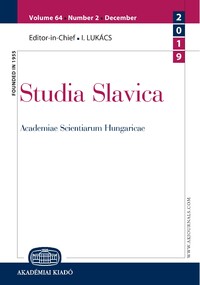О «ковидно-коронавирусных» процессах в русском языке 2020 года
An Overview of the Processes and Innovations in Russian Caused by the COVID-19 Pandemic in 2020
Author(s): Elizaveta S. Gromenko, Alina S. Pavlova, Marina N. PriemyshevaSubject(s): Lexis
Published by: Akadémiai Kiadó
Keywords: the history of the Russian vocabulary; active processes in the current Russian language; the language of the COVID-19 era; COVID-19 vocabulary; new words and meanings; lexical relations
Summary/Abstract: The paper deals with the lexical-semantic processes the Russian language has experienced during the first half of the year 2020 throughout the COVID-19 pandemic. The aim of the paper is to give a general characterization and evaluation of the phenomena and processes occurring at the period of time during which the language vocabulary gets rapidly enriched with both usual neologisms and occasionalisms. From March to June 2020, the Russian language has been subject to intense changes: a vast number of new words and notions have entered the language, a certain number of lexical units and collocations have acquired new meanings, and some of them have widened the scope of functioning: e.g. a transition of units that formerly used to belong to medical terminology or to the sphere of social life into the words of common use can be observed. The Russian language has joined the process of continuous language game and linguistic creativity. COVID, coronavirus, and corona have become the keywords of the current era as they have not only turned out to be the symbols of a certain historical period but also have served as productive stems for the formation of an enormous number of regular and occasional lexical innovations. The data presented in the paper are based on the lexical innovations published in the mass media and the Internet sources. The new lexical units were collected by the authors, who are members of the group of academic “Dictionaries of neologisms”, and collated with the large-scale mass media database “ Integrum ”, which comprises the data bank of over 30,000 mass media editions as well as records of television and radio programs. In the course of research, the following matters are examined: a number of new words and collocations which entered the language during the COVID-19 spread, the cases of forming new polysemy that the words covid, corona, and the adjectives derived from them have developed, a brief analysis of compounds with the first-component stems covid- and corona- (including the innovations that are formed by means of blending), and the investigation of obvious cases that manifest regular lexical relations (synonymy, antonymy, and homonymy) among the above-mentioned neologisms. In addition to the broad review of the neological language data, its analysis, and some scientific generalizations, one of the most important conclusions the paper arrives at is the regular character of a variety of lexical changes which have been caused by an intense and spontaneous process observed in the Russian word formation and lexical-semantic system.
Journal: Studia Slavica Academiae Scientiarum Hungaricae
- Issue Year: 65/2020
- Issue No: 1
- Page Range: 51-70
- Page Count: 20
- Language: Russian

